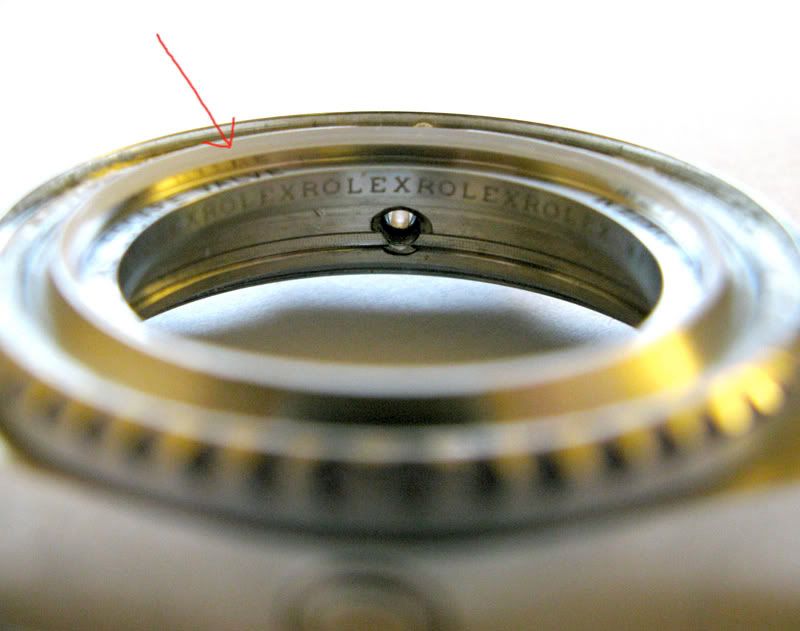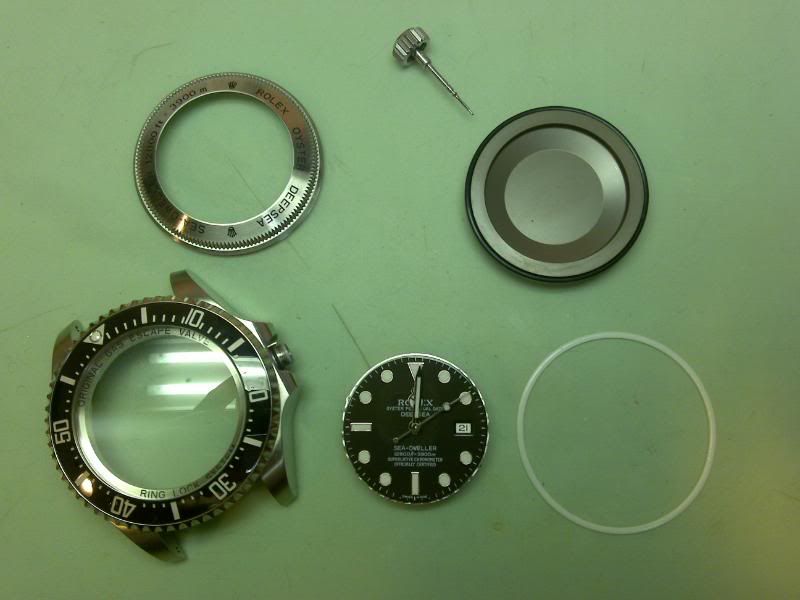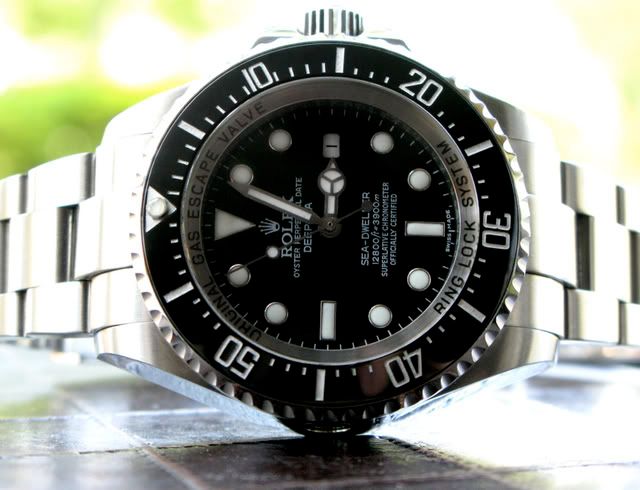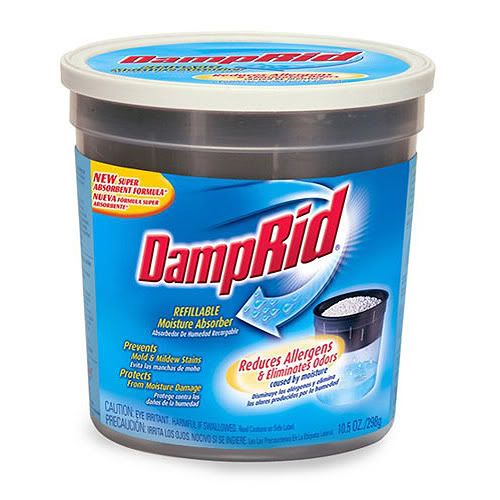since seeing a great deal of posts over time regarding this issue, here's a bit of a layman's tutorial on how to help waterproof your watches.

contrary to popular belief, these rep watches are more waterproof than they're given credit for--the sports models, mind you--not the more refined "banker's" watches like vacheron constantin, patek, etc. It's worth the extra $15, or whatever your area watch repair shops currently charge to have it pressure tested (if you're state-side, google the stores fast fix, precision time, etc.--they test any watch on site, for cheap--precision time even uses the good 6-10 atm vacuum tester, not the bergeon water one).
I've yet to have one of my own pieces (or one i've tested for somebody else) that failed waterproofing, and living on the water in florida, i swim & shower in all of mine, constantly. There's nothing i can think of more horologically absurd looking than the guys with the multi-thousand dollar sports watches who take them off before stepping into the pool. Genuine or not, nothing screams "fake" faster than a diving watch that can't get wet...
I've always tried to do my homework to make sure the reps i purchased were well researched (i.e. Closest to gen as i could get), and even went through good measure to modify them even more so--including religiously re-greasing & testing my watches a minimum of twice a year simply so that i
can swim and dive in them...
without worry.
Some examples of what's possible to achieve with proper treatment:
My ss sub 16610 always tested solid to 6 atms & was swam in chlorine pools regularly.
my 16610 lv tested the same and hit both the pool and the ocean for snorkeling.
my smp chrono tested to 10 atms & also went down to nearly 100 ft, and was in the pool on almost a daily basis.
my pam 051 also tested to 6 atms and was also in the pool almost every day i had it.
my ssd v2 tested to 6 atms but for some reason it never managed to see anything more than the inside of a shower.
my dssd v3 tested to 10 atms as well.
my v5 also tested to 10 atms and has been down to around 80 feet; it also sees daily showers and the occasional lap swim.
keep in mind--as stated earlier--these have all been treated with silicon grease and sealed up tighter than a crab's ass. I would never take a rep straight from the box into the water.never. i don't care if you actually paid extra for your dealer to supposedly "waterproof" the piece for you; i can guarantee you through personal experience it didn't happen. Qc is simply non-existent for reps when it comes to water-damage--loose case-backs, incorrectly seated crystal gaskets, no grease on the o-rings, etc.
The only pieces i've ever had that didn't hit the water were my presidential, the datejust, and my 116520.
and they
were all tested, and my smith didn't exactly say they completely failed, but did say he "wouldn't trust them". Not having a triple-lock crown is reason enough to stay out of the drink (i.e. Datejusts, daydates, etc.) the daytona i never took swimming as i was paranoid about how tight the pushers were seated.
that being said, metal on metal is impossible to water-proof; it's all about the o-rings & gaskets. And the more points of entry you have to a watch--hevs, chrono-pushers, crystals, casebacks, etc.--the more possibilities you have for leakage.
short story:
all three parts of the triple-lock system (non-rolex models will probably only have two of the following three) and case-back will need to be greased:
1) the crown's inside gasket
2) the tube's outer gasket, and
3) the tube's inner gasket
if you have silicon grease, at least apply some to the back gasket & tube gaskets if you can't get it pressure tested. This is the trick to water-tightness; well lubricated gaskets. It's actually the
rubber that seals the watch--metal on metal does
absolutely nothing for waterproofing. Also make sure the crown is screwed down tight (not too tight--as in
not wrenching it down with all your might), and make sure the caseback is on tight as well. No offense to anyone who's tried, but please don't try those ridiculous homemade pressure tests like dropping your rep in a glass of hot water looking for bubbles...
*sigh*
no need to fear the anti-rep wrath of an ad either--go to your local el-cheapo watch or jewelry repair store/kiosk; almost all have pressure testers for watches and generally charge between $10-$20 dollars to test it. I can't stress enough how important this is if you want proof-positive assurance that your piece is now sealed properly. And a $15 test is a lot cheaper than a movement overhaul.
and the not-so-short story:
if you want to go the full monty and seal your fake hev from the inside
and completely mod out the watch, check out my dssd mod-tutorial:
viewtopic.php?f=5&t=51221
if you only want to seal the hev & grease it, then here it is...
Buy some two-ply marine waterproofing epoxy (colors and brands will vary)
remove your case-back and crown--since there is no 36.5mm die on the open market until 2010, the dssds require an adjustable case-back wrench (easily and inexpensively found on amazon or ebay)
regular 40mm rolex cases will simply take a normal 29.5 mm die
release the crown by gently depressing this button with nothing smaller than a 1.1mm flathead screwdriver--pull the crown out from the time-set position while depressing the release button--take care to not push the release all the down, unless you like rebuilding keyless works or paying someone else to do it.
remove the screws holding the movement and set the movement aside.
Mix a small amount of equal portions of the epoxy
with a sharp point, apply enough to fill the hev's hole, and just slightly past the hole to insure against seepage
allow this to completely cure before putting the movement back in--drying time will vary from hours to overnight, depending on brand.
After putting the movement back in, be sure to grease the case-back gasket:
and all three parts of the triple-lock system (non-rolex models will probably only have two of the following three):
1) the crown's inside gasket
2) the tube's outer gasket, and
3) the tube's inner gasket
now, simply reinsert the crown and tighten down the case-back. Your watch should now be tighter than a neverland ranch visitor.
....
However, as people often do, if you do wind up swimming or even showering in the watch without greasing it, and it
does wind up fogging under the crystal, it's leaking--immediately remove the case-back, and pull the crown all the way out to the time-set position (this will also stop the movement from running on those movements with hacking features--2836-2, 7750s, etc.). Find a bucket of damp-rid (calcium chloride):
...and place the watch inside as soon as you can. Open the package, seal the watch inside with the lid, and leave it overnight; it will completely remove any moisture in the watch. Of course, because of the leakage, you'll eventually have to find someone to oil the watch. Light, non-salt water leaks aren't too serious, but for longevity's sake, they'll probably need an oiling sooner than they would without a leak
http://www.damprid.com/
note:
on the subject, there's sort of a catch-22 to water leakage...
in a swimming pool or spa, you're in contact with chlorine, which shrinks gaskets and
could lead to leaking (rare, and usually if it's been a while since the gaskets were greased); but chlorine water won't rust or completely destroy the movement like salt-water will. But with swimming in the ocean there's obviously no chlorine, so the salt-water is fine on the gaskets, but salt-water completely destroys movements. So your piece
might be water-tight from the box, but
please grease it first, because if it leaks, it's damned if you do & damned if you don't.
It only takes a few minutes; then you can pay a visit to your local watch repair shop and they should be able to test it for you for about $15. It only takes five minutes and will save you hundreds of dollars/pounds/euros/yuan/yen.

hope this helps you take a bit of weight off your shoulders and maybe procure a well-deserved dip, as well (i hope it's been entertaining at the very least).
Good luck, and take care!
























